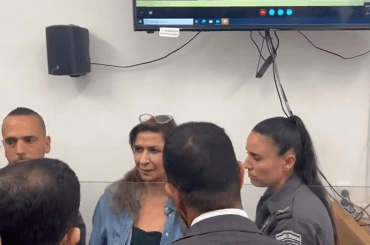Sunday, October 22, 2017, a party was thrown to celebrate the 120th Anniversary of the founding of the Jewish Worker’s Bund of Russia, Poland and Lithuania, sponsored by YIVO Institute for Jewish Research at the Center for Jewish History in Manhattan.
News of this YIVO event at the CJH provoked a campaign to stop it before it occurred. This outraged article and its comments, “Why is the Center for Jewish History celebrating anti-Zionism?”, gives a great sense of the Bundist and political Zionist stances on the place of Jews in the world.
The American Jewish Historical Society recently succumbed to pressure from right-wing Israel backers and cancelled two events on Israel/Palestine. The same forces are calling for the firing of CJH executive director David N. Myers.
The panel discussions were not focused on Israel, but it is clear why reviving this part of 20th century Jewish history triggered Zionist alarm. The Bund’s ideals of a secular Jewish identity, worker solidarity across the line of Jew and non-Jew, and respect for the Yiddish language, directly competed with the Palestine-focused, Hebrew-elevating model of Jewish development.
In the wholesale cruelty and degradation of the Shoah, a Jewish political power that sought Jewish rights in harmony with elevation of the rights of other victims of injustice and sought brotherhood of the oppressed, was gutted in the catastrophe to the Yiddish population of the world.
Palestine’s future was also affected. A phantom limb of world Jewry was missing at the time of the crisis at the end of the British Palestine mandate — the mass of non-Zionist Yiddish-speaking social democrats of the Algemeyner Yidisher Arbeter Bund in Lite, Poyln un Rusland.
The Bund in the interwar 1920-39 period provided a model of secular Jewish identity without separatism. As a successful Jewish political party in Poland, the Bund demonstrated effective Jewish participation in a multiethnic state. It demonstrated the Bund principle of Doikayt, “hereness,” working in the society in which one lives, rather than toward the religious other world, or toward a Jewish state.
Bundism favored cultural autonomy for national groups that would work together in modern states like Poland that contained distinct nationalities, rather than conceiving of a country as a monolith of one national group.
The Bund fought the idea Jews were “foreigners” in Europe, and felt that the Jewish homeland project played into that idea. As Jewish settlement in Palestine proceeded, the Bund favored a cooperative Jewish-Arab state. It found Zionism to be a nationalist ideology like the nationalisms it fought in Russia, Poland, and Lithuania.
Many people in the audience and panels had gone to Bundist camps in the United States and Australia and were third or fourth generation Bundists. One highlight was a pickup chorus of Yiddish Bundist songs, culminating with the anthem, Di Shvue/The Oath, which does not particularize to Jews the fight for economic and social justice:
Brothers and sisters of poverty and toil
who are scattered far and wide. Rally together!
Our flag is at the ready, red with blood, it waves with anger.
Heaven and earth will hear us, and the stars will bear witness.
An oath of blood, an oath of tears: we swear!



ABBA SOLOMON- “In the wholesale cruelty and degradation of the Shoah, a Jewish political power that sought Jewish rights in harmony with elevation of the rights of other victims of injustice and sought brotherhood of the oppressed, was gutted in the catastrophe to the Yiddish population of the world.”
What must be kept in mind is that the Holocaust essentially eliminated millions of Jews who were opposed to Zionism. The Zionists were a relatively small, elite supported minority among Jews prior to World War II who had difficulty recruiting Jews to immigrate to Palestine. The notion of 2000 years of Jewish longing to “return” to the sacred soil of Israel is Zionist ideology, nothing more. The current popularity of Zionism among Jews is a consequence of the dramatic increase in Zionist power since WWII, particularly after 1967.
Thank you, Solomon, for this notice and the factual reminder.
Both Zionists and “Non-Zionist” tribals have been working so hard to make the very memory of the Bund disappear –they almost have succeeded except for the rare reminder like yours.
Thanks to Phil Weiss and Co., too, for publishing.
This was a very fascinating article, thank you.
“A model of secular Jewish identity”
Only a true asshat (tnx 2 rb) true believing, Zionist hating, mediocre minded drivel would celebrate the debacle of inter-war european jewry. Of course PW would be expected to pine and slaver over the biggest failure Jews ever undertook to improve themselves and their place in society. Trusting in ‘like minded’ Lithuanian, Russian
, polish, Ukrainian, Latvian and other assorted europeans to see comradery. Nazis and communists. The best friends the Jews who migrated from Judea across northern africa and up through western Europe ever had.
The Bund may have been “the model of secular Jewish identity without separatism,” but, unfortunately, the countries they were living in were not- Poland in 1918-39 was systematically anti-semitic, with Jews discriminated against at all levels of society. Virtually every central and eastern European state (except Czechoslovakia) enacted anti-semitic legislation, quot systems, etc. during the inter-war period. The Bund continued to live in a fool’s paradise. The Zionists obviously had a better grip on reality.